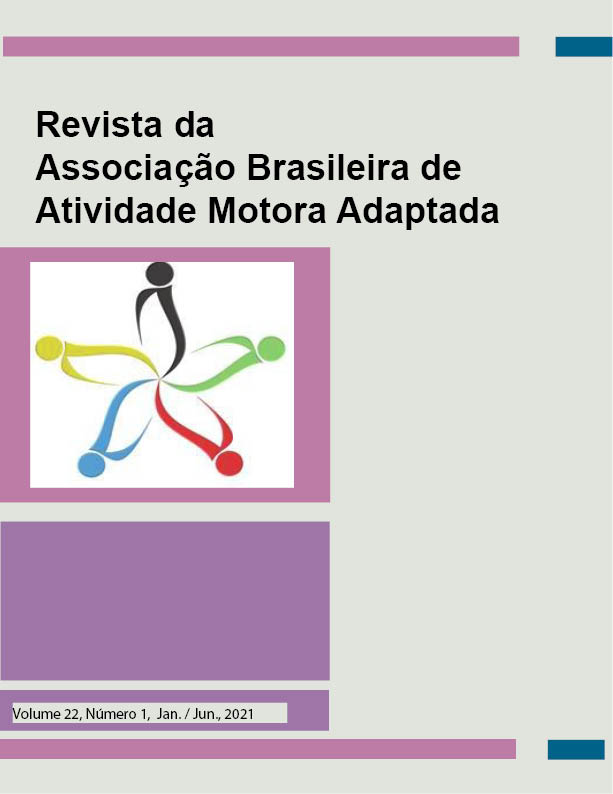EFFECTS OF JUDO PRACTICE ON THE MOTOR COORDINATION OF AUTISTIC CHILDREN AND ADOLESCENTS
DOI:
https://doi.org/10.36311/2674-8681.2021.v22n1.p3-14Keywords:
Adapted Motor Activity, Motor Coordination, Judo, Autism Spectrum DisorderAbstract
The aim of the present study was to investigate the effects of judo practice on the motor coordination of autistic children and adolescents. The sample consisted of 10 children and adolescents from six to 14 years old, autistic, male, being: five judo practitioners and school physical education classes (GJ) and five practitioners of school physical education classes (GC). All participants were students from public institutions (one school and one clinic) in the city of Belo Horizonte. To participate in the research, prior authorization from the parents was required. The evaluation of the coordinating capacities took place from the application of the Körperkoordinationstest Für Kinder (KTK). The performance presented in the subtests and the global motor quotients (QM) were analyzed. Student t test for independent samples was used to compare the groups. The results showed superiority of the GJ over the CG in the dynamic balance and monopedal jump sub tests. Regarding the QM, it was found that the GJ presented a classification of disturbance in coordination. The CG was classified as having insufficient coordination. Together, our results show that although no group has satisfactory levels of coordination, the GJ performed better than the CG, which points to the beneficial effects of the practice of judo in the coordination of autistic children and adolescents.
Received on: 2020/08/14
Reformulated on: 2021/01/14
Accepted: 2021/01/14
References
ARAUJO, P.R.M., NETO, J.M.“Benefício do Judô na Educação Física e sua Regulamentação”Revista Uni-RN, Natal, v.16, v.17, suplemento, p. 43-49, jan/dez. (2017).
AUTISM 2014, THE AUTHOR (S) 2014 Reprints and permissions: sagepub.co.uk/journalsPermissions.v.18 (5) 482–484.
CONFEDERAÇÃO BRASILEIRA DE JUDÔ (Brasil). UNESCO declara Judô como esporte mais adequado para crianças. Disponível em: https://www.cbj.com.br/noticias/2924/unesco-declara-judo-como-esporte-mais-adequado-para-criancas.html. Acesso em 21 de maio de 2019.
FOURNIER, K.A., HASS, C.J., NAIK, S.K., LODHA, N., CAURAUGH, J.H. Motor coordination in autism spectrum disorders: a synthesis and meta-analysis. Journal of Austim and Developmental Disorders. 2010 Oct; 40(10):1227-40. Doi/;10.1007/s10803-010-0981-3
GIL A. C. Como Elaborar projetos de pesquisa. - 4. ed- São Paulo: Atlas,2002, p.54.
GORLA, J.I., RODRIGUES, J.L., BRUNIEIRA, C.A.V., GUARIDO, E.A. (2000). Teste de avaliação para pessoas com deficiência mental: identificando o KTK. Arquivos de Ciência da Saúde da Unipar, 4(2), 121-128.
GORLA, J.I.,ARAÚJO, P.F., & CARMINATO, R.A. (2004). Desempenho psicomotor em portadores de deficiência mental: avaliação e intervenção. Revista Brasileira de Ciência do Esporte- 25, n.3, p. 133-147.
GORLA, J.I.,ARAÚJO, P.F., & RODRIGUES, J.L. (2009) “Avaliação Motora em Educação Física Adaptada – Teste de KTK” 2 ed. São Paulo: Phorte Editora.
GORLA, J.I., ARAÚJO, P.F., COSTA, L. T & SILVA, N.A.C. (2010) Performance of balance beam task of KTK by people with intellectualdisability.Revista Brasileira Movimento e Percepção.
GORLA, et.al. (2014) “Avaliação Motora em Educação Física Adaptada – Teste de KTK” 3 ed. São Paulo: Phorte Editora.
MANDELL,David;LECAVALIER,Luc.(2014) “Should we the centers for Disease Control and Prevention s autism spectrum disorder prevalence estimates?” sagepub.co.uk/journalsPermissions. Vol. 18(5) 482–484.
ORRÚ, S. E. Autismo, Linguagem e Educação: interação social no cotidiano escolar. 3.ed. Rio de Janeiro: Wak Editora, 2012, p17.
OLIVEIRA, C.: Um Retrato do Autismo no Brasil – Revista Espaço Aberto: USP, abril 2018. ed. 170.
SANTOS, Érick Tárlen de Melo. Desenvolvimento motor associado à prática do judô na infancia. 2013. 37f. Monografia (Especialização) - Curso de Licenciatura em Educação Física, Universidade Federal de Goiás, Formosa-Go, (2013).
SILVA JÚNIOR, L.P. Avaliação do perfil motor de crianças autistas de 7 a 14 anos frequentadoras da Clínica Somar da cidade de Recife - PE. Campina Grande, 2012. 75f.Trabalho de Conclusão de Curso (Graduação em Licenciatura Plena em Educação Física) - Universidade Estadual da Paraíba.
SILVA, S.G., LOPES, D.T., RABAY, A.A.N., SANTOS, R.M.L., MOURA, S. “Os Benefícios da Atividade Física para Pessoas com Autismo” –Revista Diálogo em Saúde. vol.1 nº1 jan/jun. (2018).
SCOTT, S.; KOZUB, F. M.; GOTO, K. Tae Kwon Do for Children with Autism Spectrum Disorder.Palaestra; winter 2005; v. 21 (1), p. 40, 2005. In Silva, et. al., (2018).
KIPHARD, E. J., & SCHILLING, V. F. (1974). Körper-koordinations-test für kinder KTK: manual Von Fridhelm Schilling. Weinhein: Beltz Test. In Gorla, et. al., (2014).




